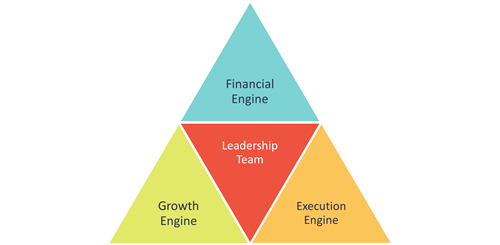
Key insights
- You’re focused on growing your business — increasing revenue, expanding your team, and serving more customers. But growth alone doesn’t guarantee future success. Enhancing business value is essential.
- Profitability is a strategic decision driven by effective leadership, operational excellence, and the ability to maintain steady cash flow, all of which enhance business value.
- If you’re not intentionally building business value, you could be leaving opportunity on the table when it comes time to sell, transition, or scale.
- And when leaders plan ahead for transitions, the business can keep its momentum — and business value — no matter who’s at the helm.
Build business value now to create a transition-ready future.
You’re growing your business — but are you growing its business value? The decisions you make today may shape your future transition.
Buyers and successors often look for businesses that are resilient, scalable, and well-managed — not just profitable. Learn how strategic foresight, operational excellence, and adaptability can help improve your personal and business outcomes.
What drives future business value? It’s not just the numbers
Business value isn’t just about profit. It’s the sum of your company’s financial health, operational excellence, leadership strength, and growth management.
For entrepreneurs and business owners, business assets often account for a significant portion of their net worth. Maintaining the value of these assets is important for protecting the financial future of owners and those who rely on them, including employees, families, and communities.
Many believe strong financial performance is key to increasing business value, and while it's crucial, buyers also consider how sustainable those results are. This long-term outlook depends less on current financials and more on other often-overlooked aspects of the business.
Strong financial performance relies on a solid business model and disciplined adherence as conditions change. Market growth, effective execution, and strong leadership are key drivers leading to successful outcomes.
Top 4 ways to help increase business value
A simple visual model illustrates interdependency and teamwork — and the competencies required to achieve long-term success. Excellence in any of these areas can create bursts of short-term success. However, consistent attention to all four often creates high-performance organizations that can compete in the global marketplace.

1. Financial performance
Top-performing businesses recognize that profitability can stem from intentional choices and disciplined management. Rather than reacting to market shifts, they focus on what they can control — their practices, processes, and priorities — to help drive consistent financial performance.
When businesses scale without upgrading their financial tools or planning for complex obligations, cash flow can quickly become a challenge. But those that invest in strong financial systems that support growth are better equipped to grow sustainably, make smart decisions, and attract partners who value stability and long-term vision.
Capturing financial metrics
Digital technology helps businesses capture, analyze, and act on financial data with greater speed and precision. Modern ERP systems, cloud-based accounting platforms, and integrated dashboards provide real-time visibility into key financial metrics like cash flow, gross margin, inventory turnover, and operating costs.
With automated data collection and advanced analytics, your leadership team can shift from reactive to predictive financial management. They gain the ability to model scenarios, track performance against targets, and identify cost-saving opportunities.
Businesses that strike a balance between improving profitability and reducing business risk can create more succession options for their owners. Watch our on-demand webinar for tips to enhance your business value.
2. Growth management
Growth-minded organizations understand two key drivers of business valuation:
- How revenue is distributed
- How clearly their value proposition resonates with the market
Revenue concentrations — whether by customer, sector, capability, or geography — are common, but they also present opportunities. Businesses that actively expand and diversify their revenue streams can reduce risk and unlock new paths for growth. Those that move beyond reliance on a single customer or industry can position themselves to thrive in changing conditions.
A clearly defined value proposition is a powerful growth engine
When aligned with customer needs, differentiators like engineering excellence, product quality, and delivery reliability often outperform price in competitive markets.
For small and mid-sized businesses, these strengths can open doors to new sectors, geographies, and partnerships — fueling sustainable growth and increasing appeal to future buyers.
Growth through digital transformation
Digital transformation empowers companies to pursue growth more strategically by unlocking new markets, streamlining operations, and enhancing customer engagement.
Leveraging connected technologies helps you:
- Evaluate workflows
- Reduce equipment downtime
- Respond faster to customer needs
- Scale more efficiently
It also helps promote diversification — reducing your company’s reliance on concentrated revenue sources and enabling expansion into new sectors.
3. Execution
Execution is what turns potential into performance — and performance into value.
Strong execution means having a reliable operating system — not just software, but a rhythm of accountability, communication, and performance tracking that makes operational excellence routine. Don’t wait for problems to escalate; instead, proactively anticipate, adapt, and respond.
Execution can protect and enhance company assets — from equipment and inventory to talent and customer relationships. Businesses that execute well tend to be more profitable, require less working capital, and are better positioned to grow without overextending.
For buyers, this signals a lower-risk investment and a higher likelihood of future success, which directly boosts valuation.
Use digital tools for execution
With digital tools, execution plans don’t just live in slide decks — they’re translated into measurable actions, workflows, and KPIs visible across your organization.
Digital transformation strengthens execution by embedding intelligence, consistency, and agility into daily operations. Tools like operations execution systems and real-time dashboards help you monitor performance, track progress against goals, and respond quickly to issues — all in a unified environment.
4. Leadership
While leadership teams naturally evolve over time, forward-thinking organizations treat this evolution as an opportunity — actively planning for transitions, assessing business risks, and nurturing future leaders to keep momentum strong.
For small to mid-sized companies, this shift presents a chance to reimagine leadership, bring in fresh perspectives, and build on the foundation already in place.
Business transitions, when approached thoughtfully, can be a catalyst for innovation and renewal. Organizations that begin planning early are better positioned to increase enterprise value, support continuity, and create a future that benefits both current and incoming leaders.
Strong succession planning can make or break a deal
Effective succession and transition planning doesn’t just prepare your business for change — it can actively its market value. Buyers often place a premium on businesses with stable leadership, clear continuity plans, and a strong team beyond the owner.
Building a scalable leadership structure and reducing dependency on any one individual helps position your business as a lower-risk, higher-reward investment.
How CLA can help you build business value
Many business owners wait too long to think about succession or sale. But the reality is: the earlier you start planning, the more options you’ll have.
CLA’s industry-focused professionals can help you with tax structuring, strategic planning, financial analysis, and improving operational efficiency through digital transformation. We’ll work with you to build a practical growth plan designed specifically for your company, your goals, and your values.
Whether you're preparing for ownership succession, executive retirement, or a broader leadership shift, our approach enables a smooth and strategic business transition — aligning stakeholders, clarifying roles, and maintaining operational continuity.
